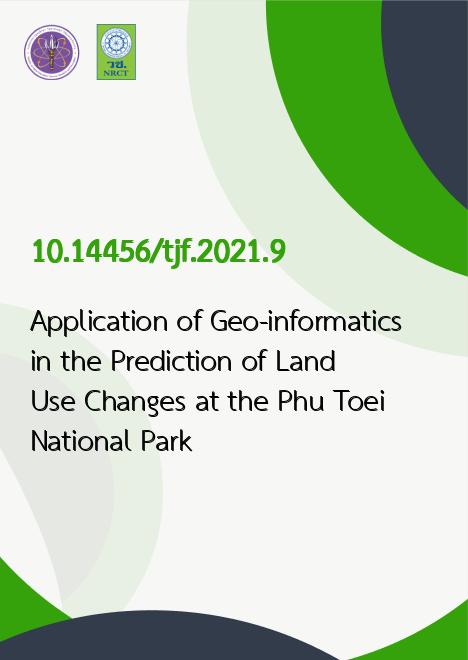
|
Application of Geo-informatics in the Prediction of Land Use Changes at the Phu Toei National Park |
|---|---|
| รหัสดีโอไอ | |
| Creator | Phongsiri Poonperm |
| Title | Application of Geo-informatics in the Prediction of Land Use Changes at the Phu Toei National Park |
| Contributor | Wanchai Arunpraparut, Prasong Saguantam |
| Publisher | Kasetsart University |
| Publication Year | 2564 |
| Journal Title | Thai Journal of Forestry |
| Journal Vol. | 40 |
| Journal No. | 1 |
| Page no. | 123-138 |
| Keyword | Geo-informatics, Land use change, CA-Markov, Phu Toei national park |
| URL Website | https://li01.tci-thaijo.org/index.php/tjf/article/view/248885 |
| Website title | Thai Journal of Forestry |
| ISSN | 2730-2180 |
| Abstract | The objective of this study was to apply geo-informatics in the prediction of land use changes at the Phu Toei National Park. The visual interpretation classification technique was used to classify the land use during the years 1995, 2007, and 2019. Markov chain and Cellular Automata were then used as a tool to predict the land use in 2031. Our results indicate that the study area covered around 864.31 km2, consisting of Phu Toei National Park and a surrounding area within a radius of 3 km. from the boundary of the National Park. Land use was classified into 5 types consisting of forest land, agricultural land, urban and built-up land, water bodies, and miscellaneous. Data analysis revealed that during 1995 2007, land use changes occurred in an area of size 84.76 km2 or 9.81% of the total area. The ratio of change in land use area indicated that the forest land had the highest change of around 42.38 km2 or 50%. The area under agriculture increased by 35.17 km2 or 41.49%. In 2007 2019, the land use change occurred in an area of around 5.96 km2, which was 0.34% of the total area. The ratio of land use changes indicated that area classified as forest type changed at the highest rate by 2.98 km2 or 50%. The area under urban and built-up land increased by 1.89 km2 or 31.67%. The overall accuracy of prediction using CA - Markov model was 84.55%. Cellular Automata predicted land use during 2031 under forest land, agricultural land, urban and built-up land, water bodies, and miscellaneous areas of 589.60, 257.19, 2.87, 14.64, and 0.01 km2, respectively. The conversion of forest land to agricultural land needs proactive surveillance measures and appropriate land use problem solving, especially in Ban Ta Pern Kee, Ban Kluai, Ban Ong Phra, Ban Wang Nhormai, Ban Nong Eenag, Ban Huai Hindam, Ban Wangyao, Ban Wang Jorakhae, Ban Lawawangkwuai, and Ban Wang Hora. |